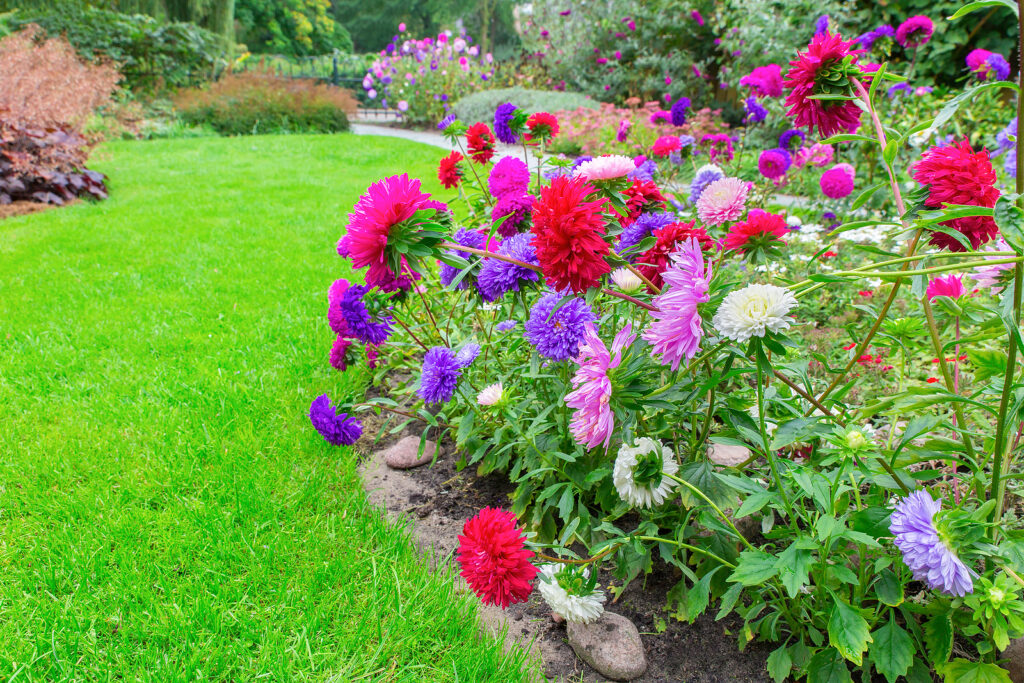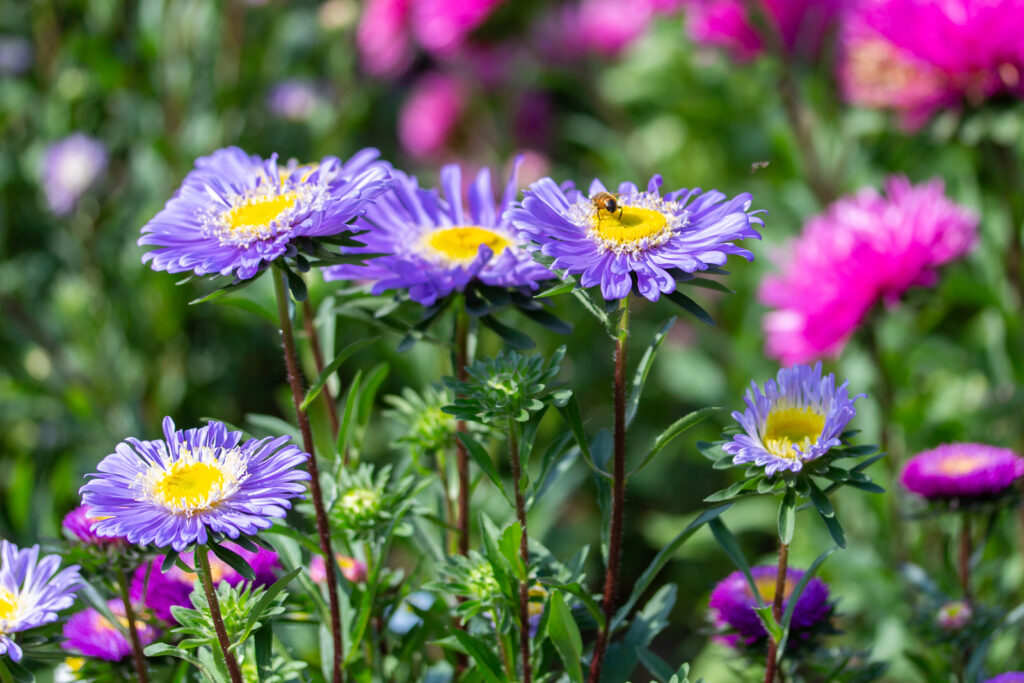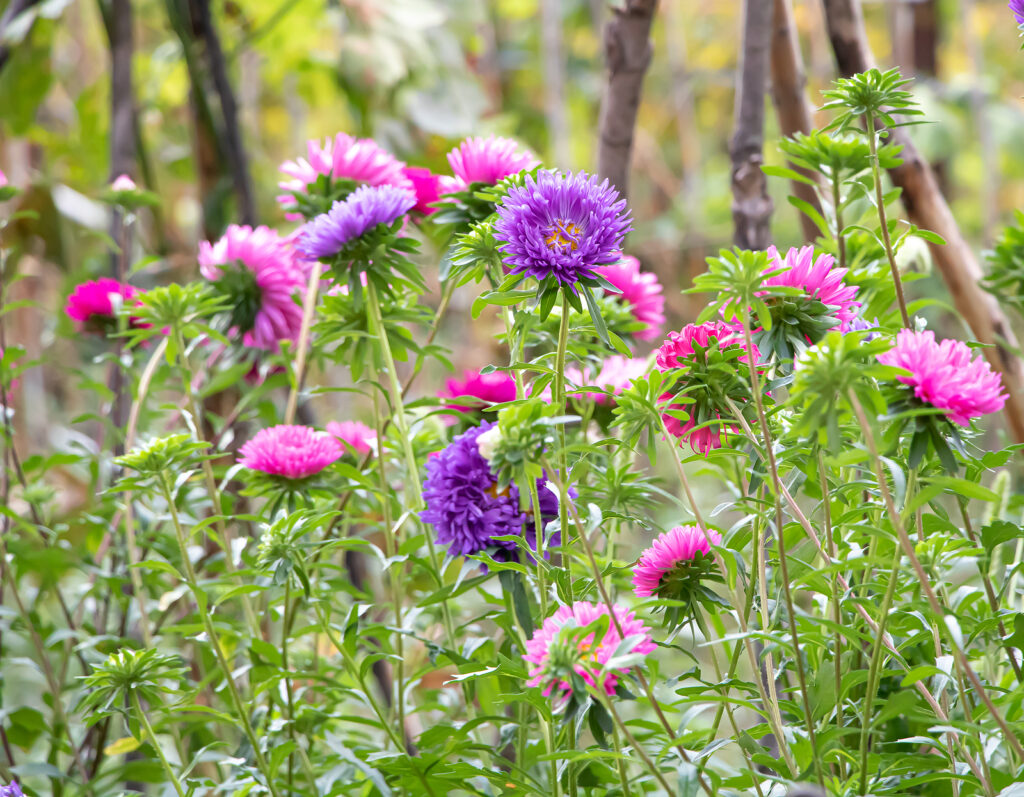Callistephus–commonly called China asters–are big frilly flowers in shades of red, pink, white, lavender-blue, and purple. Low-growing asters can be used as edging, taller ones of cutting. China asters bloom from late summer to frost.
China asters belong to one of two distinct genera of plants both of which are members of the daisy family. China asters are annuals; the second group is hardy asters, also called Michaelmas Daisies (see separate article).
China aster, Callistephs chinensis, is a lush and spectacular annual. The plants grow from 12 to 30 inches (30-76cm) tall and are much-branched. The flowers average 2 to 3 inches (5-7.6cm) across and appear on wiry stems/ They come in all shades of lavender, purple, rose, pink, crimson, and white.
China asters grow best in a bit of shade although they will do well in cool sunlight. they prefer moderately rich soil. China asters are relatively easy to grow.
Start seeds indoors in spring; when the weather warms sow seed outdoors. Sow seed every 2 weeks for at least 6 weeks to have a long season of bloom. Individual plants are short-lived.
China asters have long stems and make good cut flowers.
Callistephus is a genus of one species native to China.

Get to know Callistephus – China Aster
- Plant type: Annual
- Growing Zones and range: Summer annual in all zones
- Hardiness: Grow between frosts in spring and fall; killed by frost, sensitive to high heat.
- Height and width: 6 to 36 inches tall (15-91cm), 12 to 18 inches (30-45cm) wide, depending on variety
- Form: Low growing bushy plant with oval, lobed, toothy green leaves.
- Flower form: Small round daisies; individual disc and ray flowers, 2 to 5 inches (5-12cm) wide, on long stems, single or double
- Flowers colors: White, creamy yellow, pink, red, blue, mauve, or purple, often with yellow centers.
- Bloom time: Late summer to early fall
- Uses: Color for late-season beds and borders; grow in masses; cutting garden and containers
- Garden companions: Pot marigolds
- Common name: China aster
- Botanical name: Callistephus chinensis
- Family: Asteraceae
- Origin: China
Where to plant Callistephus – China Aster
- Grow China asters in full sun.
- Plant China asters in humus-rich, well-drained soil.
- China asters prefer a soil pH of 6 to 7.5.
Callistephus – China Aster uses
- Use Callistephus in borders; they are outstanding when massed in colors.
- Asters are excellent cut flowers with long stems and handsome foliage; asters quit blooming when they are cut.
- Use dwarf varieties for edgings and patio containers.
- Callistephus can be grown indoors in a sunny window.
- You can extend the flowering season of Callistephus by planting early-, mid-, and late-season varieties or by planting succsessively through spring.

When to plant Callistephus – China Aster
- Set established China asters in spring after all danger of frost has passed.
- Sow seed indoors 6 weeks before the last frost; set seedlings out 2 weeks after the last frost.
- Sow seeds outdoors after all danger of frost has passed in spring.
- Set plants outdoors if the weather is warm with no danger of frost.
Planting and spacing Callistephus – China Aster
- Sow seeds indoors in six-packs and pots; cover seed with 1/8 inch soil; keep seeds at 65° to 75°F (18°-24°C); seeds germinate in 7 to 14 days.
- Sow seeds outdoors 2 inches (5cm) apart, cover with 1/8 inch soil.
- Thin seedlings when they are 2 inches (5cm) tall; transplant seedlings when they are 6 inches (15cm) tall.
- Set transplants outdoors when the weather is warm and there is no danger of frost.
- Space China asters 6 to 12 inches (15-30cm) apart.
How to water and feed Callistephus – China Aster
- Keep the soil evenly moist.
- Fertilize China asters every 4 weeks with an all-purpose fertilizer or add a slow-release fertilizer to the soil before planting.

Callistephus – China Aster care
- Mulch around plants with aged compost to conserve soil moisture.
- Replant China asters every few weeks for continuous blooms.
- Stake tall varieties.
- Pinch off the stem tips in early summer to promote branching.
- Remove spent flowers to encourage new blooms.
Callistephus – China Aster pests and diseases
- China asters are prone to aster yellows virus, Septoria leaf spot, rust, wilt diseases, and gray mold. Avoid planting in the same spot where the disease has previously struck.
- Control aphids, leafhoppers, and mealybugs with soap sprays.

Callistephus propagation
- Plant seeds outdoors barely covering them after all danger of frost has passed.
- Seeds germinate in 8 to 10 days at 70°F (21°C); germination can be as low as 55 percent.
- For a succession of blooms, start a few plants indoors six weeks before the last frost in spring.
- Callistephus do not like transplantiung.
Callistephus – China Aster varieties to grow
- There are many China aster cultivars; dwarf forms are 6 to 12 inches tall, medium forms are 12 to 18 inches tall, tall forms are 18 to 36 inches tall. Petals may be single or double, shorter or longer, curved or straight, quilled or flat.
- ‘Famil Silvery Blue’ has fluffy, incurved white blossoms touched with lavender-blue to 36 inches tall.
- ‘Florette Champagne’ has pink quilled petals.
- ‘Giant Single Andrella’ flowers in shades of wine, rose, blue, and purple and white with a golden center.
- ‘Matsumoto Mix’ in all colors with a golden center, to 16 inches tall.
- ‘Ostrich Plume’ is wilt resistant.
- ‘Pinocchio’ border plants in yellow, white, rose, pink, and lavender.
- ‘Totem Pole’ with double flowers in shades of blue, scarlet, cherry, red, and white.















